Mary Frances, born 1918, died in 2014.
Mary Frances, born 1918, was the eldest survivor of the fourteen children of Marie Blanche and Charlie. As the eldest child in an ever-expanding family, more responsibilities were thrust upon her in the chaos of living with her mother’s in-laws on the edge of Tignish.
There is only one photograph of Frances in her childhood dating from the earliest years, and with her in the photo is her beloved sister Elise.
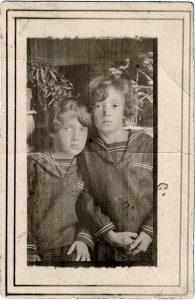
Education
Around 1925 Frances was sent a short distance up the road to be educated by the Sisters of Notre Dame at the great brick convent of that name built in 1868. It is a fine but terribly austere Georgian style structure.
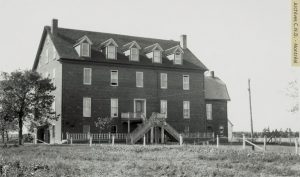
The classrooms were located on the third floor and were entered through the back door of the kitchen wing, along a tortuous staircase which passed the sacristy door of the chapel.
Her time there was brief and brutal. The family could not afford to dress Frances in the manner desired by the nuns, and she suffered for it. Physical and verbal abuse were the order of the day and many of the sisters delivered instruction laced with frequent slaps across the face. Attendance was spasmodic, not encouraged by almost-illiterate parents, and so Frances was not a star student. She did learn to read, write, and calculate. Around 1930, having possibly achieved Grade 4, she was deemed fit to go out and earn her living. She was then about 12 years old.
1930, at the age of 12, Frances enters the work force.
Probably because the great local entrepreneur Clarence Morrissey was a neighbour of her grandfather, Joseph Isidore Gaudet, arrangements were made for her to go and work in his huge fish factory at the Black Marsh near North Cape. She would have joined a number of other small boys and girls employed in small easy tasks until they grew older and could accept more responsibility. They lived in dormitories and slept on straw and were fed the leftovers in the kitchens. Frances would have rarely gone home during this time as the Black Marsh is about 9 miles from Tignish. Sometimes she walked home, along the dirt roads and through the fields.

The Mysterious Undocumented 1930s
The chronology of these years is very vague as no records were kept and Frances refused to help me recreate the 10 or so years from leaving school to moving to Halifax to work during the years of World War II. As far as I can make out, they were years of slavery, physical and sexual abuse, a time completely devoid of love and affection. No child in the village could have had a worst time.
The Tignish Run
Probably because her father fished for the Myrick enterprise at the Tignish Run Frances stopped working at the Black Marsh, nine miles away, and joined the other children working for the Myricks in their fish factory. Since the harbour was only about 1.5 miles from the village she would have gone home after work, taking a short cut in a century-old path through the woods and swamp that took her behind the cemetery, minutes from her grandparents house where her family lived.

The Myrick Fish Factory at the Tignish Run, circa 1915-20. Photo from the Tignish Arts Foundation Collection.
The trip home through the woodland path was filled with menacing terrors. Once, with a far away look she told me how the local boys hid in the woods to frighten her. As they got older their attention turned from teasing and name calling to sexual advances. Inevitably a particularly unpleasant and violent boy raped her and this may have resulted in pregnancy.
Frances enters domestic service.
The story of Frances is filled with mystery for this period, but she once – the only time ever – confided to her niece that she became pregnant. In those days Catholic girls who became pregnant out of wedlock were often sent to convents run by the Sisters of Notre Dame for the period of their confinement. When born, the baby would be given away for adoption. This appears to be what happened to Frances and, while waiting for the child to be born, she was taught how to be a house and kitchen maid so that, disgraced, she could leave Tignish and find employment in Summerside or Charlottetown.
This is what happened. One of the Holman families in Summerside employed her as a kitchen maid and her time there was pleasant, she recalled, because for the first time ever she was treated as a human being by her civilised and cultivated employers. Frances remembers Mr. Holman putting her on the train to Tignish one Christmas, laden with food and small presents. She never forgot this first great kindness in her life, and in her old age we made a pilgrimage to Summerside to stand in front of the Holman house where she was first recognised as a human being worthy of kindness instead of endless blame and guilt.
In the late 1930s Frances moved to Charlottetown where, if I remember correctly, she became a servant to a Mrs. White who was extremely kind to her, fed her well and dressed her, and in her solitude, sought companionship with her.
Wartime in Halifax
When World War II broke out Frances was 21, had emerged from a home life of abuse and neglect, survived the child labour of the fish factories, the sexual violence of savage boys, and a newfound dignity as a human being in domestic service. She was ready to move on and the War provided a means of escape and self-determination as an independent adult.

The War brought an incredible amount of employment opportunities, especially in places like Halifax whose port was one of the great military bases of the region. In what seems like no time at all Frances, joined by her younger sister May, and other girls from Tignish who had been friends and neighbours, was employed in Halifax in a pharmacy that also had a restaurant. It was a very popular spot for hundreds of sailors whose ships docked in the harbour and who went looking about for amusement.
In the drugstore/restaurant there was one of those photographic machines where, after you dropped a coin in a slot and quickly sat in the cubicle, a strip of fully developed black and white picture, still smelling of developer chemicals, would drop town into an outside receptacle. It was the custom at that time, and well into my teen years, to have these little black and white photos coloured by hand while you waited. Both Frances and May were taught how to colour the photos and over time, they accumulated dozens of these little photos, of themselves and their sailor friends. It seems as if there were very happy moments, and this photo of Frances, the first since the one with her sister Elise from the early 1920s, show a bright-eyed attractive Frances, photographed against an improbably Dutch background.
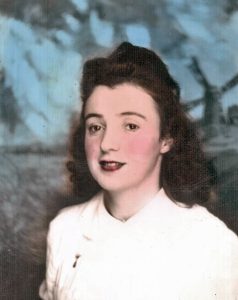
Her hair is long and piled up on top of her head in the style of the day. The hair would get longer and higher in the early 1940s, and there were many happy photos documenting this, but almost every one of them was destroyed by her sister May when, in 1962, she married above her class and destroyed any physical evidence of her humble origins.
After Frances died, I found this photo of her very fashionably dressed, and with a great victory roll, which is what those enormous rolls of hair that framed the face were called. She is near a cemetery, and I expect this was taken in Halifax around 1942. She is very elegant, showing great stylish poise.

Frances meets Jimmy Porter
One of the sailors that Frances met was a young fellow from Montreal called James MacKenzie Porter, of Scottish Presbyterian origins. He was a year older than Frances, having been born in 1917.
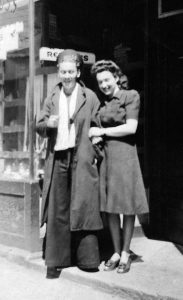
Jimmy Porter and Frances, Halifax, 1942.
He was handsome, musical, and deadly charming and Frances fell in love. Miraculously a photograph of the pair has survived, standing in front of the pharmacy where Frances worked. Her victory rolls are taller than ever in her state of triumph. This is the first time that she was in love and had, so it appeared, a real boyfriend who cared for her. Soon she became pregnant, and he quickly dropped her. He had every reason to. He was engaged to an upper-class girl from Saint John, and on November 30, exactly one week after I was born, they married in splendour.
A son is born.
My birth, which took place in the Summerside hospital, was a difficult one as I was born with jaundice. Until I could recover sufficiently, Frances lived in the country near Kensington with her godparents, Malvina and Mike Doucette. By March 1944 I was sufficiently recovered to be able to travel and all three got on the train and took me to her parents, Charlie and Marie Blanche, in Tignish. I was hastily baptised as James Reginald Porter, with Malvina and Mike as my godparents, and then I was abandoned. The story concocted and spread about the village was that Frances’ husband’s ship had gone down and he had drowned. The widow left their child with her parents while she went back to work to earn money to support the family. And that is what she did. She returned to Halifax for the rest of the war.
Frances’ younger sister Susan, who was fifteen at the time, and passionate about cats, dolls and dancing, become my surrogate mother. Marie Blanche, having just the year before lost the ninth of her fourteen children, could not cope.
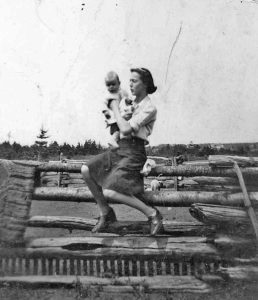
Susan with Reggie, summer, 1944.
Frances returned to Halifax until the end of the war and employment dried up. Several of the Tignish girls went to Moncton where they got jobs in the great Eaton’s Department Store. It was soon time for Susan to grow up and start earning a living and she too moved to Moncton and the kind employment of Mr. Eaton. Marie Blanche had to take over caring for me but by that time I could crawl and have vivid memories of exploring the space under the kitchen table where my grandfather’s friends and Marie Blanche played cards every night except for Sunday. They played games called Auction 45 or Five Cents a Corner. I crawled under the table to be close to people and remember being surrounded by boots that smelled of horse shit.
In the summer of 1948 or ’49 Susan came home for a joyous visit and I was in transports of joy. It was so good to see her again. But something terrible happened. She simply collapsed in front of the house where she was playing with me. I could not understand what was happening. She was taken to Alberton, then to Summerside, and then to the Tuberculosis Sanitarium in Moncton. She had been stricken by tubercular meningitis of the brain and spine.
She was expected to die, so severe was her illness. The family agreed to allow the doctors to experiment with the new miracle drugs, Streptomycin and Aureomycin. She was pumped full of these drugs and they saved her life, in the process causing her to become almost deaf and arresting her emotional development.
Frances cared deeply about Susan, the surrogate mother of her child, and she visited Susan often in the hospital. Several photos were taken, one of which I found among my mother’s papers after she died.
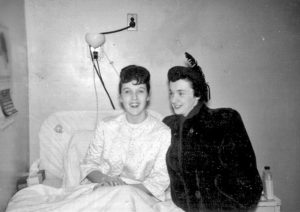
Frances visits Susan in the Moncton Sanitarium
Frances decided that since Susan might not live her mother should come to see her, possibly for the last time. Mary Blanche and I boarded the bus very early one morning and headed for Moncton. I was terrified of motor vehicles, knowing, and loving only horses, so the trip was a great stress. We stayed in the basement apartment where the Tignish girls lived on Botsford Street and I was reunited with my mother, who seemed glad to see me. An affectionate photo survives.
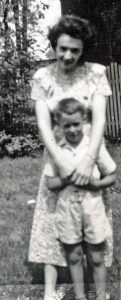
Frances and Reggie, Moncton, circa 1949.
My mother did not really know me, having only had one week of contact with me per year since I was born when she came to Tignish for her annual vacation. In the basement where their apartment was located, she found a boy’s wagon and a large teddy bear – the biggest I had ever seen! There were brought outside and aired and I was allowed to play with them. Of course, I fell in love and wanted them. My snivelling exasperated Frances so much that she slapped me across the face, no doubt exactly as her mother had slapped her. I was photographed again, shortly after the slap and the tears, and the photo, tell the whole story of our subsequent relationship until her death.
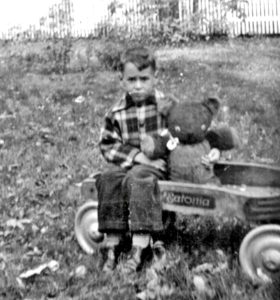
Reggie. Moncton, 1949.
The Montreal Years.
By the early 1950s Susan recovered sufficiently to be discharged from hospital. She went home to Tignish to stay with her mother. Frances and May, along with their old friends from Tignish moved on to Montreal. May went on to a lengthy career at Eaton’s, working all those years in the belt and glove department. I have no idea what Frances’ first job was.
A number of other people from Tignish also lived and worked in Montreal at this time and there would be happy weekend gatherings.
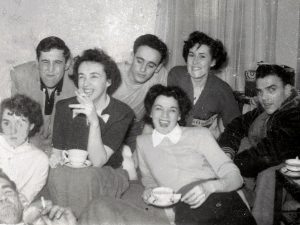
The Credit Bureau of Montreal Years
Quite early on Frances got a job at The Credit Bureau of Montreal where she worked for many years as a credit investigator, spending her days on the phone gathering and analysing data from credit applicants. She was very good at her job and while kindly appreciated by her various bosses she was harassed for years by one of her supervisors. As the years went on this brought great misery into her life and she had to live with the knowledge that this state of things would go on for a long time until she reached retirement age.
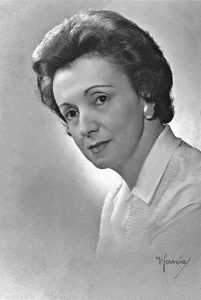
Employee photo of Frances taken at The Credit Bureau for their annual report.
Frances loved to dress and had good taste in clothes. She set up good long-term relationships with various clothing merchants who were very kind to her.
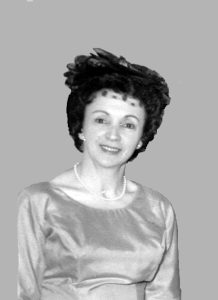
August 1958 – Her son Reggie finally comes to live with Frances.
When her child from Jimmy Porter was born Frances abandoned him with her parents in Tignish when he was well enough to travel, having been born with a bad case of jaundice. I was 14 and had spent the previous years receiving physical and verbal abuse in a home and a community where I was not wanted.
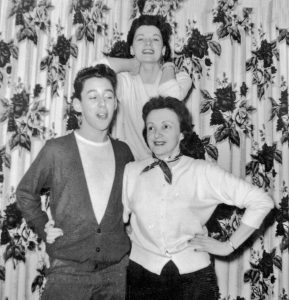
Reggie with Frances and May, circa 1959 or ’60.
My time with my mother in Montreal will be told in the following chapter of this blog. With her modest income performed miracles to pay for the huge additional expense of having me around. I was always well-dressed and well-fed and to some degree, welcomed into the family and the milieu of their Montreal friends.

Frances and May with their best friends spending an evening chatting and drinking. My memories of these visits are very pleasant.
The Birth of Larry
The birth of her first nephew, Lawrence “Larry” to her brother Gerard and his wife Vera was to be a great event in her life. Not having had any experience at all in bringing me up and loving a child she devoted all her spare time to babysitting and introducing Larry to fascinating in his environment. This went on for years, well into his adulthood.

The Cottage at Anglo Shore
As she got older, and with money carefully saved, thoughts of retirement began to obsess Frances. She had decided to take an early retirement and go back to spend the rest of her life in Tignish. Energetically she set about finding a small building she could afford and had it moved to the edge of the sea on her sister May’s large lot at Anglo Tignish. Little by little she turned this scruffy building, inside and out, into a very comfortable cottage where she could live year-round.

May lived very close by in a large new house built after her husband Fred died. There she brought all the fine furniture she had in her posh Montreal apartment and reigned supreme as the Queen of Anglo. Local people rushed to play cards at her house and eat her very elaborate post-game lunches. The nature of these new guests was light years away from the people with whom she had tried to associate in the Town of Mount Royal in Montreal.
There were very pleasant family gatherings at May’s grand house and some lovely photographs of those five survivors of Charles and Marie Blanche’s huge family survive. It was a pleasant time where memories of their destitute origins were suppressed and only happy things were talked about.
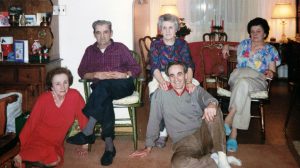
The Garden Years
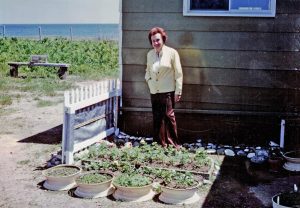
Francis took up gardening at her cottage and experimented with different beds and containers. She was very proud and happy at her new skill.
During those years I would visit my mother regularly, especially at birthday time and Christmas. From time to time, I drove down with friends to show them the lovely location of my family’s last days. One such visit was in the summer of 1983 when this photo was taken. Physical affection had never been part of life with my mother and it is a good thing that this very rare example was recorded on that day.
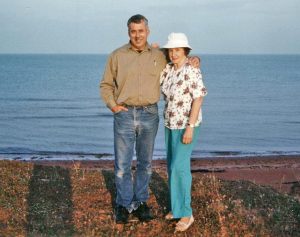
Reg and Frances at Anglo, Summer 1983.
Age and Poor Health Cause Frances to Move to Town
In her early 80s Frances began to experience various health problems, one of them requiring complicated heart surgery. Life in isolated Anglo, where yearly the unstable cliff on which her cottage was placed eroded away at an alarming rate, Frances decided to rent a small flat at the Davis Lodge in Tignish. It was close to the church and only a ten-minute walk from the stores in Tignish.
She spent a great deal of time decorating her little flat with her many favourite pictures of members of the family but also with her ever-growing collection of books. She was an enthusiastic fan of L M Montgomery and in these years at the shore and in town I was able to give her the complete stories of Anne of Green Gables, quite a few of them in first editions. In her last years she had about 200 books in her collection, many of them the works of Canadian writers like Margaret Atwood, Farley Mowat, Lenard Cohen, Antonine Maillet and Mordecai Richler. She was fluent in both French and English.

Christmas 2007
A Long Life filled with Love, Generosity and Never-Endling Sacrifice
Frances lived to be 96 and was absolutely determined to live to 100! Her love of life – in spite of the many severe traumas that punctuated it – was intense. She had a wicked sense of humour, as they say in Tignish, and was always ready to see the funny side of things, no matter how difficult things were. It was always get up and move on.
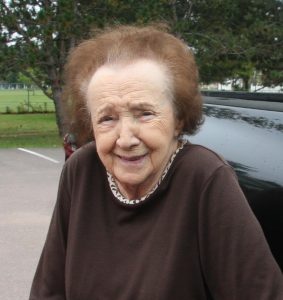
Her last picture – 2011 October 2002
Frances was my mother but we were never close. I wanted evidence of her love and she wanted me to go to the top. In between were uncountable fights and long periods of silence.
But my gratitude to her is undying. She instilled in me the cautious attitude to the world which has guided the decisions of my life, and she reigns supreme as an example of a woman filled with love and loyalty, who overcame every obstacle to be there for the ones she loved.